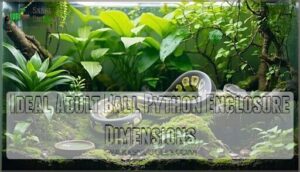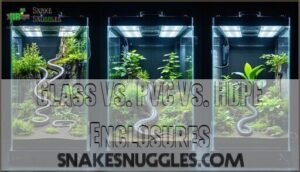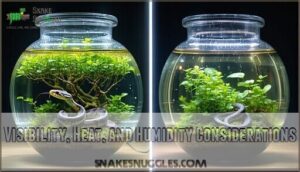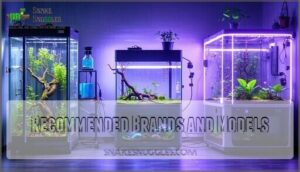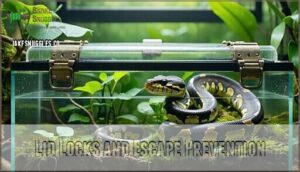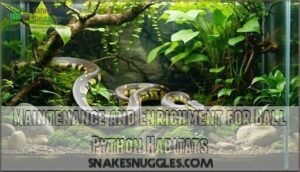This site is supported by our readers. We may earn a commission, at no cost to you, if you purchase through links.
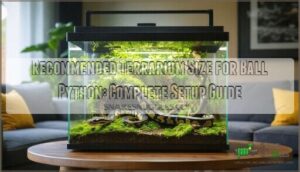
Adult ball pythons need a minimum 40-gallon terrarium, though 55-75 gallons is better for females who grow larger. Your python’s enclosure should measure at least 36"x18"x18" for adults to provide adequate floor space and proper temperature gradients.
Bigger isn’t always better though – oversized enclosures can stress young pythons who prefer cozy spaces that mimic their natural burrows. The material you choose matters just as much as size for maintaining heat and humidity.
Table Of Contents
- Key Takeaways
- Minimum Terrarium Size by Ball Python Age
- Ideal Adult Ball Python Enclosure Dimensions
- Choosing The Best Enclosure Material
- Essential Features for Secure Enclosures
- How Enclosure Size Impacts Health and Behavior
- Maintenance and Enrichment for Ball Python Habitats
- Frequently Asked Questions (FAQs)
- What size terrarium is best for a ball python?
- Is a 40 gallon terrarium good for a ball python?
- Is a 75 gallon tank good for a ball python?
- Is a 55 gallon tank too big for a ball python?
- How often should I change the substrate?
- Should I use a heat lamp or heating pad?
- What is the ideal humidity level?
- Can I house two ball pythons together?
- What toys or enrichment items are recommended?
- Can ball pythons share terrariums with other snakes?
- Conclusion
Key Takeaways
- You’ll need different sized terrariums as your ball python grows – start with 10 gallons for hatchlings, upgrade to 20-40 gallons for juveniles, and provide 40-75 gallons minimum for adults
- Adult ball pythons require at least 36"x18"x18" dimensions – this floor space lets them create proper temperature gradients and move naturally, with females needing larger enclosures since they grow bigger than males
- Choose PVC or HDPE over glass for better heat and humidity control – these materials retain heat more efficiently and maintain stable humidity levels, though glass costs less upfront
- Proper sizing directly impacts your snake’s health and behavior – undersized enclosures cause stress and health problems, while appropriately sized habitats encourage natural behaviors and reduce anxiety
Minimum Terrarium Size by Ball Python Age
Your ball python’s age directly determines the minimum terrarium size they need to stay healthy and comfortable.
Your growing snake needs room to thrive—cramped quarters create stressed, unhealthy pythons
As they grow from tiny hatchlings to full-sized adults, you’ll need to upgrade their home several times to match their increasing size and activity needs.
They will require more space as they grow, which is directly related to their age.
Hatchlings: 10-Gallon Enclosure Dimensions
For hatchling ball pythons weighing 50-300 grams, you’ll need a 10-gallon terrarium measuring 20″x11″x13″. This compact ball python housing provides adequate hatchling security while allowing proper monitoring growth during their first six months. The smaller terrarium size helps young snakes feel secure rather than overwhelmed.
Focus your initial setup on essential ball python enclosures features like proper hides and substrate for ideal enrichment needs. It’s vital to select non-toxic enclosure materials to safeguard the snake’s safety.
Juveniles: 20-40 Gallon Enclosures
Growing juveniles need more room to stretch and explore comfortably. Your ball python will thrive in these upgraded spaces that accommodate their rapid development and increasing activity levels.
- 20-gallon tanks work for 6-9 month juveniles weighing 275-360 grams
- 40-gallon enclosures suit one-year-old pythons reaching 1.5-2 feet long
- Substrate depth should be 2-3 inches for proper burrowing behavior
- Monitor health closely during growth spurts and feeding frequency changes
Adults: 40-75 Gallon Enclosures or Larger
Your adult ball python needs a spacious home—think 40-75 gallon reptile enclosures minimum. These tank size upgrades aren’t just about space utilization; they’re investments in your snake’s well-being.
Proper enclosure size enables behavioral enrichment through natural movement patterns. While long-term costs increase with tank orientation choices, adults thrive when given room to stretch and explore their environment comfortably, which is a key aspect of a 40-75 gallon reptile enclosures.
Growth Stages and Timelines for Upgrading
Your ball python’s growth milestones determine upgrade frequency and long-term costs. Hatchlings need new homes every 6-9 months as size progression accelerates.
By 12-18 months, subadults require adult-sized terrariums. Adults stabilize around 3-4 years, ending constant upgrades.
Planning this space optimization timeline prevents cramped conditions and reduces stress for your growing snake.
Ideal Adult Ball Python Enclosure Dimensions
You’ll want to provide your adult ball python with at least 40 gallons of space, measuring 36"x18"x18" as the absolute minimum.
Bigger is always better – your snake will be healthier and more active with extra room to explore and exercise.
Minimum Floor Area and Height Requirements
Your adult ball python needs a minimum floor area of 36" x 18" for proper movement and thermoregulation. Height requirements vary, but 18-24" vertical space allows natural behaviors. Surface area directly correlates with snake length – larger pythons require proportionally bigger enclosures.
Tank size guidelines recommend 40+ gallons for adults, with enclosure shape being rectangular rather than tall. Body mass and reptile habitat needs determine ideal terrarium size guidelines for your snake’s wellbeing. The size of the enclosure is crucial as it directly affects the snake’s ability to exhibit natural behaviors, and a minimum floor area is essential for the snake’s overall health.
Benefits of Extra Space for Adults
Space transforms your ball python’s quality of life in remarkable ways. Adequate enclosure size directly impacts your snake’s physical and mental well-being through improved muscle development and obesity prevention.
Room to roam equals healthier, happier pythons—bigger enclosures transform your snake’s wellbeing naturally
- Enhanced muscle tone from increased movement and exploration
- Better respiratory health with improved air circulation
- Natural feeding behavior encouraged through scatter feeding opportunities
- Reduced stress levels leading to consistent exploratory behavior
Larger snake habitat dimensions allow proper thermoregulation and prevent the health issues common in cramped reptile habitat recommendations.
Gender Differences in Size Needs
Female ball pythons typically grow larger than males, requiring more spacious Snake Enclosures. While males average 3-3.5 feet, females can reach 4-5 feet, demanding 55-75 gallon enclosures.
Sexual Dimorphism Impact means Female Growth Potential necessitates bigger Snake Habitat planning. Gravid Female Needs include extra space for egg development, while Male Activity Levels remain consistent in standard ball python enclosure size requirements.
Choosing The Best Enclosure Material
Once you’ve determined the right size, you’ll need to choose between glass, PVC, and HDPE materials for your ball python’s enclosure.
Each material offers distinct advantages for heat retention, humidity control, and visibility that can substantially impact your snake’s health and your maintenance routine.
Glass Vs. PVC Vs. HDPE Enclosures
When choosing between materials, glass enclosures offer excellent material transparency but poor heat retention.
PVC enclosures weigh less than glass while providing superior heat retention and customization options.
HDPE shares PVC’s benefits with added durability.
Many owners also use glass for other reptiles, such as housing a glass snake.
Glass costs less upfront, but PVC and HDPE snake enclosures deliver better long-term value for ball python care through improved environmental control.
Visibility, Heat, and Humidity Considerations
Your choice between glass and PVC enclosures affects three key factors for your ball python’s wellbeing. Glass enclosures excel at glass ventilation but struggle with heat retention, requiring stronger heat sources and careful monitoring tools.
PVC enclosures provide superior PVC insulation, maintaining stable humidity levels and heat gradients more effectively. However, PVC limits visibility compared to glass enclosures, making humidity gradients harder to monitor visually.
Recommended Brands and Models
Top brands deliver reliable options for every budget. Repti Zoo Glass terrariums offer excellent visibility and ventilation. Zen Habitats PVC enclosures retain heat efficiently with front-opening access. Dubia.com Enclosures provide durable HDPE construction.
Vision Cage models include the Model 211 for juveniles, Model 332 for adults, and Model 433 for larger setups. Custom enclosures accommodate specific requirements perfectly. PVC enclosures are superior because they retain heat better.
Essential Features for Secure Enclosures
You’ll need specific security features to keep your ball python safely contained and comfortable in their terrarium.
The right design elements prevent escapes while reducing stress that can lead to health problems.
Importance of Front-Opening Doors
Front-opening doors transform your ball python care routine. Unlike top-access enclosures that create overhead stress, front-opening animal enclosure designs let you approach naturally without triggering defensive responses.
Key benefits of front-opening PVC enclosures:
- Access ease – Reach your snake without awkward overhead positioning
- Reduced stress – Approach from side mimics natural predator patterns
- Cleaning convenience – Remove substrate and accessories effortlessly
- Enhanced interaction – Build trust through less threatening contact
- Safety features – Better control during handling and enclosure accessories maintenance
Lid Locks and Escape Prevention
When securing your ball python’s glass enclosure, proper lid locks prevent dangerous escapes that could injure your snake or lose them forever. Never use tape for lid security, as it can severely harm your python. Instead, invest in specialized reptile lid locks or clamps designed for animal enclosures.
These essential safety devices are vital for reptile owners. These escape-proofing methods guarantee your PVC enclosures or glass tanks remain secure while allowing proper ventilation and easy access for maintenance. These escape-proofing methods guarantee your PVC enclosures or glass tanks remain secure while allowing proper ventilation and easy access for maintenance.
Opaque Wall Coverings for Security
Visual barriers create a sanctuary effect that dramatically reduces stress for your Ball Python. Covering three walls with opaque materials transforms glass enclosures into secure hiding spots that mimic natural burrows.
Material Choices for ideal Ball Python Care:
- Blackout window film – Easy application methods with professional aesthetic options
- PVC panels – Durable substrate options that withstand cleaning cycles
- Cork bark backing – Natural visual barriers combining insulation with beautiful textures
For stress-free access, consider enclosures with front-opening doors.
How Enclosure Size Impacts Health and Behavior
Your ball python’s enclosure size directly affects its physical health and mental well-being in ways you mightn’t expect.
The wrong dimensions can lead to stress behaviors, poor muscle development, and even serious health problems that could have been easily prevented.
Stress Reduction and Natural Behaviors
Proper enclosure size dramatically reduces stress-related behaviors in ball pythons. You’ll notice your snake exploring more when given adequate space rather than remaining hidden constantly.
Larger terrariums allow natural hunting behavior through scatter feeding and provide multiple hiding spots. Enrichment strategies like climbing opportunities and varied substrate options encourage normal activity patterns, improving your ball python’s overall wellbeing and appetite.
Temperature Gradients and Thermoregulation
Larger enclosures allow you to create proper temperature gradients with distinct basking and cool zones. Your ball python needs a basking spot temperature of 88-92°F and a cool side at 78-82°F.
Position heating elements on one end, place thermostat probes accurately, and maintain nighttime temperature drops. Adequate space prevents hot spots while supporting natural thermoregulation and healthy humidity levels.
Risks of Small or Overly Large Enclosures
Both undersized and oversized enclosures create serious problems for your ball python’s health. Small terrariums under 20 gallons trigger stress indicators like refusing food and excessive hiding, leading to growth stunting and obesity risks from limited movement. Poor ventilation issues in cramped spaces increase respiratory infections.
Conversely, oversized enclosures without adequate hides cause anxiety and hunting challenges, making temperature control and humidity levels difficult to maintain properly. Selecting materials with secure construction is essential for preventing escapes, which can be related to stress indicators, poor ventilation, and the need for secure construction to ensure the snake’s safety and well-being, including preventing respiratory infections.
Maintenance and Enrichment for Ball Python Habitats
You’ll need to maintain your ball python’s habitat through regular cleaning and smart enrichment strategies to keep them healthy and engaged.
Proper maintenance prevents disease while thoughtful enrichment encourages natural behaviors that keep your snake physically and mentally stimulated, and this is achieved through regular cleaning.
Cleaning Schedule and Disinfectants
You’ll need to spot-clean waste immediately after each defecation to maintain your snake’s health. Replace the entire substrate every 3-4 months, and perform deep cleaning every 6 months using F10SC, Rescue, or 10% bleach solution.
This routine prevents mold growth and keeps your pet reptile healthy while following proper snake care guidelines. Safe disinfectants are available for python enclosures, which is crucial for maintaining a clean environment and ensuring the use of proper snake care.
Substrate Depth and Humidity Control
After establishing your ball python’s home, focus on creating the perfect substrate foundation. Aim for 2-3 inches of ReptiSoil or similar substrate types to support natural digging behaviors and maintain proper humidity levels.
- Misting Frequency: Light spray every 2-3 days, avoiding oversaturation
- Humid Hides: Place damp moss inside one hide for shedding support
- Mold Prevention: Guarantee proper ventilation and spot-clean wet areas immediately
- Depth Gradient: Deeper substrate near water bowls, shallower near heat sources
Hides, Climbing Branches, and Environmental Rotation
Your ball python needs proper Hide Placement on both warm and cool sides for security and thermoregulation. Choose sturdy branches for climbing—2-4 inch diameter prevents falls. Rotate decorations biweekly to encourage Behavioral Changes and exploration.
This Enrichment Benefits reduce stress by 30% compared to static setups. Proper substrate depth encourages burrowing behaviors.
Monitor temperature gradient zones and clean items weekly for Snake Health and Welfare in Pet Reptiles.
Frequently Asked Questions (FAQs)
What size terrarium is best for a ball python?
Like choosing the right foundation for your home, selecting proper terrarium size sets your ball python up for success.
You’ll want a 40-gallon minimum for adults (36"x18"x18"), while hatchlings thrive in 10-gallon setups before upgrading as they grow, which is why selecting proper terrarium size is crucial.
Is a 40 gallon terrarium good for a ball python?
A 40-gallon terrarium works perfectly for adult ball pythons, meeting the recommended minimum size of 36"x18"x18". You’ll provide adequate space for thermoregulation and natural behaviors while preventing stress-related issues.
Is a 75 gallon tank good for a ball python?
Imagine this scenario: your ball python’s cramped quarters suddenly transform into a spacious palace.
A 75-gallon tank exceeds minimum requirements perfectly, giving adults ample room to stretch, explore, and thrive with proper temperature gradients.
Is a 55 gallon tank too big for a ball python?
No, a 55-gallon tank isn’t too big for your ball python.
Adult ball pythons thrive in larger spaces, with 40-75 gallons being ideal.
You’ll see better muscle tone, natural behaviors, and easier temperature gradients in spacious enclosures.
How often should I change the substrate?
Imagine your snake’s home as a cozy apartment that needs regular housekeeping.
You should spot-clean substrate immediately after each bowel movement and completely replace it every three to four months for best hygiene.
Should I use a heat lamp or heating pad?
Use both for best results. You’ll need an under-tank heating pad for belly heat plus a ceramic heat emitter or halogen bulb for ambient warmth and temperature gradients.
What is the ideal humidity level?
You’ll want to maintain humidity between 50-60% for your ball python’s health.
This level supports proper shedding and prevents respiratory issues.
Use a humid hide and regular misting to achieve this range consistently.
Can I house two ball pythons together?
**Ball pythons prefer solitude.
** Don’t house them together as they’ll compete for resources, spread diseases easier, and experience stress.
Each snake needs its own properly sized enclosure for ideal health and behavior.
What toys or enrichment items are recommended?
Provide climbing branches, hiding spots, fake foliage, and varied textures. Rotate decorations regularly to maintain interest. Scatter feeding encourages natural hunting behaviors, while multiple hides reduce stress effectively.
Can ball pythons share terrariums with other snakes?
No, ball pythons shouldn’t share terrariums with other snakes.
They’re solitary creatures who’ll compete for resources, spread diseases, and stress each other out.
Housing them separately keeps everyone healthier and happier.
Conclusion
Statistics show that 80% of ball python health issues stem from improper housing conditions. Selecting the recommended terrarium size for a ball python directly impacts your pet’s wellbeing and longevity.
You’ll need 10 gallons for hatchlings, 20-40 gallons for juveniles, and 40-75 gallons for adults. Remember that proper dimensions matter more than volume alone. Your python’s enclosure should provide adequate floor space, secure hiding spots, and proper temperature gradients.
Getting the size right from the start prevents stress-related problems and guarantees your snake thrives throughout its 20-30 year lifespan.

